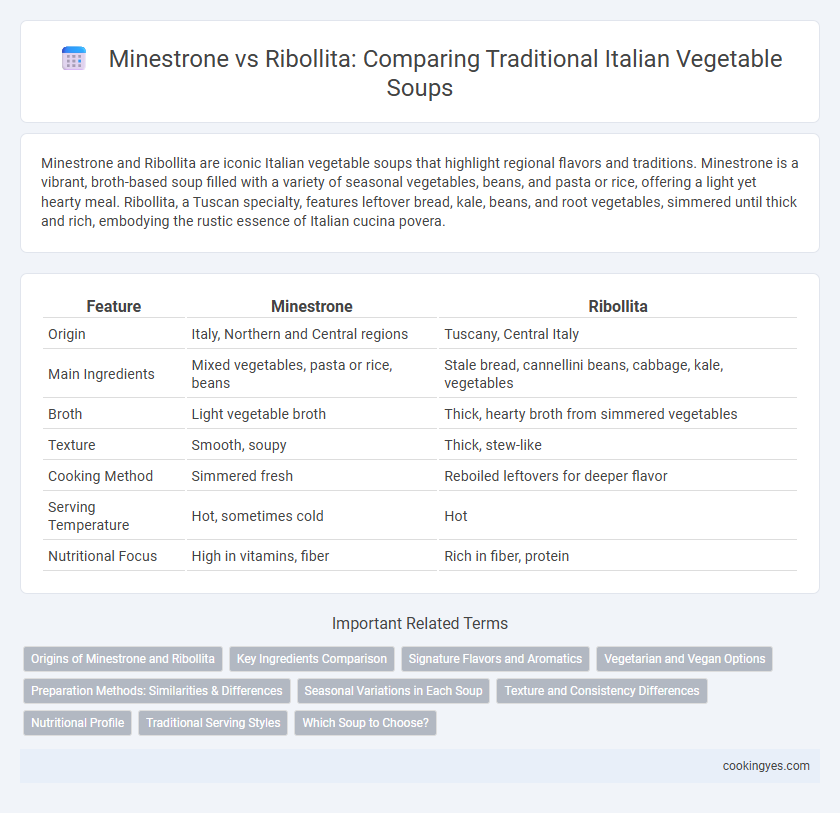Minestrone and Ribollita are iconic Italian vegetable soups that highlight regional flavors and traditions. Minestrone is a vibrant, broth-based soup filled with a variety of seasonal vegetables, beans, and pasta or rice, offering a light yet hearty meal. Ribollita, a Tuscan specialty, features leftover bread, kale, beans, and root vegetables, simmered until thick and rich, embodying the rustic essence of Italian cucina povera.
Table of Comparison
| Feature | Minestrone | Ribollita |
|---|---|---|
| Origin | Italy, Northern and Central regions | Tuscany, Central Italy |
| Main Ingredients | Mixed vegetables, pasta or rice, beans | Stale bread, cannellini beans, cabbage, kale, vegetables |
| Broth | Light vegetable broth | Thick, hearty broth from simmered vegetables |
| Texture | Smooth, soupy | Thick, stew-like |
| Cooking Method | Simmered fresh | Reboiled leftovers for deeper flavor |
| Serving Temperature | Hot, sometimes cold | Hot |
| Nutritional Focus | High in vitamins, fiber | Rich in fiber, protein |
Origins of Minestrone and Ribollita
Minestrone originates from ancient Roman cuisine, traditionally featuring a variety of seasonal vegetables, beans, and pasta or rice, reflecting its role as a hearty, flexible soup for peasants. Ribollita, a Tuscan specialty, evolved as a thrifty dish using leftover bread, kale, beans, and vegetables, its name meaning "reboiled" to signify its preparation by reheating twice. Both soups showcase Italy's rich agricultural heritage, with minestrone emphasizing diverse vegetable combinations and ribollita highlighting rustic, Tuscan ingredients and culinary resourcefulness.
Key Ingredients Comparison
Minestrone features a vibrant mix of seasonal vegetables such as zucchini, carrots, celery, and beans, combined with pasta or rice for heartiness. Ribollita highlights hearty Tuscan staples including cannellini beans, cavolo nero (black kale), stale bread, and root vegetables, creating a dense, stew-like texture. Both soups emphasize fresh vegetables but differ in grain use and regional ingredient specificity, with Ribollita relying on rustic bread and kale, while Minestrone incorporates diverse pasta shapes and a broader vegetable variety.
Signature Flavors and Aromatics
Minestrone showcases a medley of fresh vegetables like zucchini, carrots, and tomatoes, enhanced by aromatic herbs such as basil and oregano, creating a vibrant and light flavor profile. Ribollita, a Tuscan classic, highlights the rich, earthy notes of kale, cannellini beans, and stale bread, simmered with garlic, rosemary, and sage for deep, comforting aromas. Both soups use olive oil as a key ingredient, yet Minestrone emphasizes bright, garden-fresh flavors while Ribollita delivers a hearty, smoky essence.
Vegetarian and Vegan Options
Minestrone and Ribollita are iconic Italian vegetable soups celebrated for their rich flavors and hearty textures, both offering excellent vegetarian and vegan options. Minestrone features a vibrant mix of seasonal vegetables, beans, and pasta or rice, making it high in fiber and plant-based protein, while Ribollita stands out with its slow-cooked Tuscan kale, cannellini beans, and stale bread, creating a thick, comforting stew rich in antioxidants and complex carbohydrates. Both soups emphasize fresh, natural ingredients, making them ideal choices for plant-based diets seeking nutritious and authentic Italian flavors.
Preparation Methods: Similarities & Differences
Minestrone and Ribollita both feature slow-cooked vegetables and beans, but Minestrone is typically prepared fresh with a variety of seasonal vegetables simmered in broth, while Ribollita involves reheating leftover Tuscan bread and vegetables to create a hearty, thick stew. Minestrone often includes pasta or rice, cooked separately before combined with the soup, whereas Ribollita uses stale bread to thicken the soup, enhancing its rustic texture. The key difference lies in Ribollita's double-cooking method, which deepens flavors by reheating the soup, compared to Minestrone's single simmering process.
Seasonal Variations in Each Soup
Minestrone adapts to seasonal ingredients, featuring spring peas and fresh tomatoes in warmer months, while autumn versions incorporate root vegetables and kale. Ribollita emphasizes hearty winter vegetables such as cabbage, cannellini beans, and stale bread, making it a robust choice for colder seasons. Both soups reflect regional Italian traditions through their use of locally available, seasonal produce.
Texture and Consistency Differences
Minestrone features a lighter, broth-based consistency with a variety of diced vegetables, beans, and pasta, offering a fresh and chunky texture. Ribollita is a thicker, heartier soup characterized by its creamy, porridge-like consistency, achieved through the slow cooking of stale bread and Tuscan kale that blend seamlessly with the vegetables. The texture contrast highlights Minestrone's crispness and ribollita's rich, velvety mouthfeel, making each distinct in traditional Italian vegetable soup offerings.
Nutritional Profile
Minestrone boasts a rich nutritional profile with a diverse mix of vitamins, fiber, and plant-based protein from ingredients like beans, tomatoes, and seasonal vegetables. Ribollita, a Tuscan classic, offers a hearty blend of nutrient-dense kale, cannellini beans, and stale bread, providing a significant source of iron and complex carbohydrates. Both soups are low in fat and high in antioxidants, making them excellent choices for health-conscious diets.
Traditional Serving Styles
Minestrone is traditionally served as a broth-based soup with a variety of fresh vegetables, beans, and pasta or rice, often topped with grated Parmesan cheese for added flavor. Ribollita, a Tuscan specialty, is a thick, hearty soup made from leftover bread, cannellini beans, kale, and other greens, typically reheated and served as a rustic, dense dish. Both soups highlight regional Italian culinary customs, with Minestrone offering a lighter, more versatile option, while Ribollita emphasizes slow-cooked textures and robust, earthy flavors.
Which Soup to Choose?
Minestrone features a variety of fresh vegetables, beans, and pasta, offering a lighter, more broth-based option ideal for a refreshing meal. Ribollita, originating from Tuscany, is a thicker, heartier soup made with stale bread, kale, cannellini beans, and root vegetables, perfect for a filling, rustic experience. Choose Minestrone for a vibrant, versatile soup and Ribollita for a comforting, traditional option rich in Tuscan flavors.
Minestrone vs Ribollita for Italian vegetable soups Infographic

 cookingyes.com
cookingyes.com